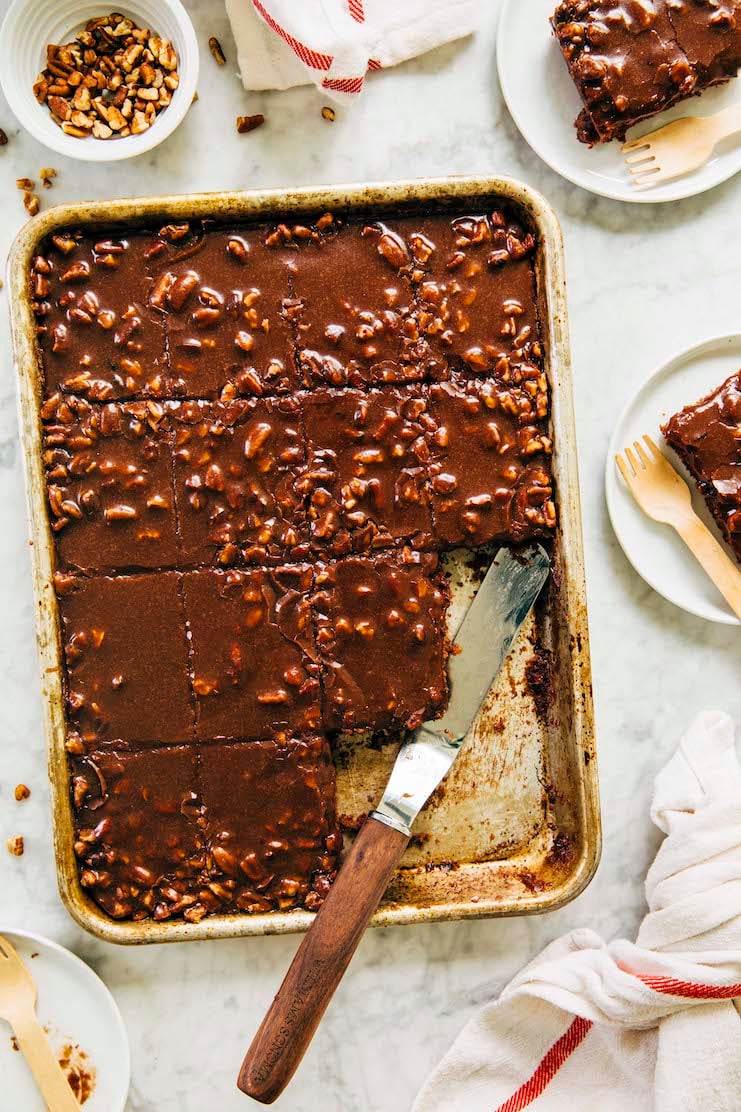
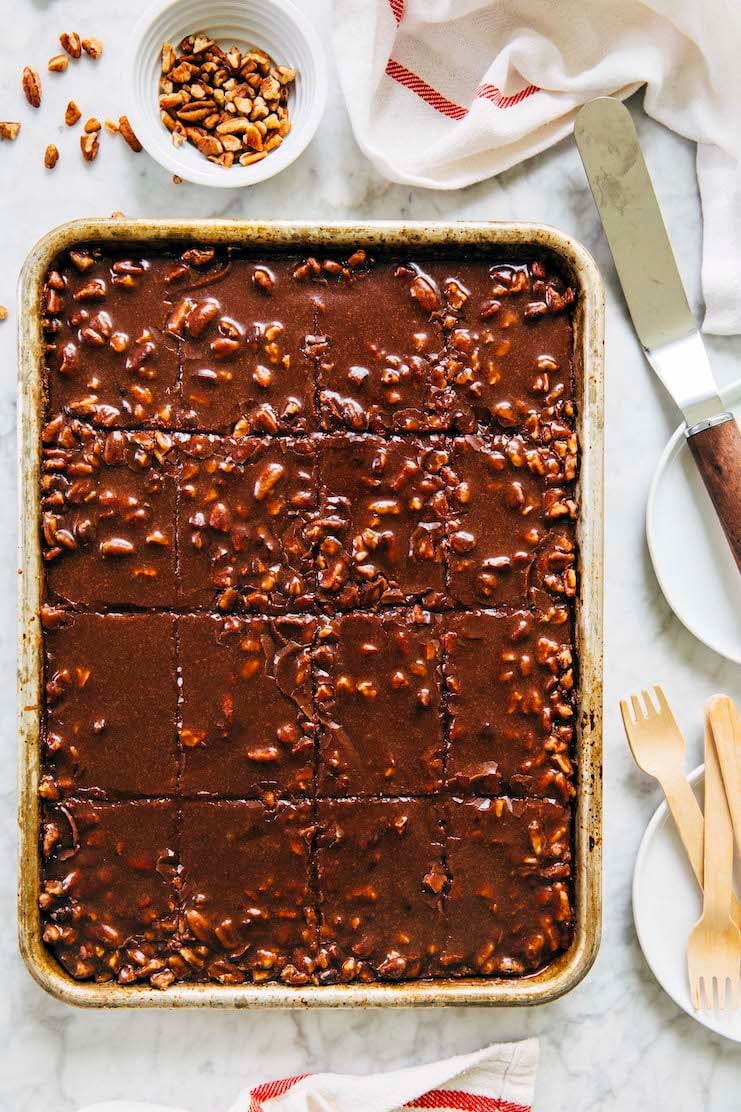
About This Texas Sheet Cake Recipe for 9 x 13 Inch Pan
This Texas sheet cake recipe for a 9 x 13 inch sheet pan is a small batch version of classic Texas sheet cake! Like the original, this cake is made with a thin layer of super moist chocolate buttermilk sponge cake, topped with a thick layer of chocolate fudge frosting and studded with pecans. It is surprisingly light for a sheet cake, making it absolutely addicting and delicious!
However, traditional Texas sheet cake recipes serve a crowd. Many recipes instruct you to make the cake in a 13 x 18-inch jelly roll pan. However, this recipe makes a half batch of Texas sheet cake for a smaller group. I instruct you to bake the cake in a more accessible 9 x 13-inch sheet pan!
Looking for more sheet pan cake recipes? Check out Hummingbird High‘s Cake recipe collection! Popular recipes include this White Texas Sheet Cake Recipe For 9 x 13 Inch Pan
and this Guava Chiffon Cake with Guava Cream Cheese Frosting.
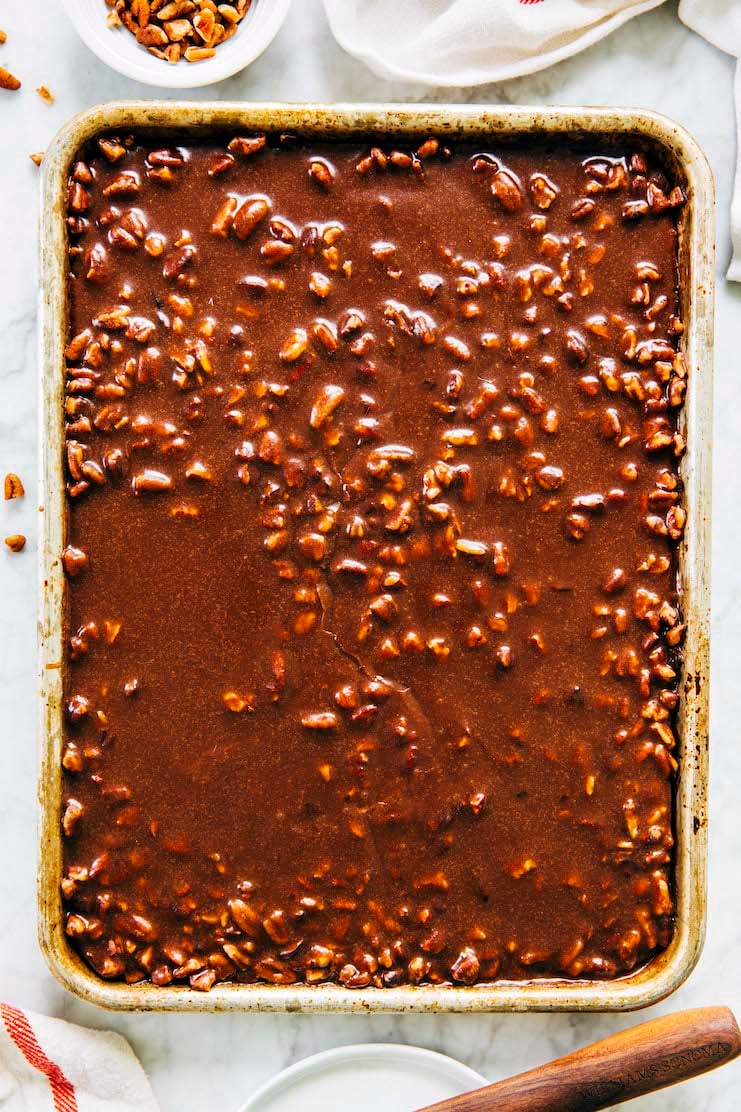
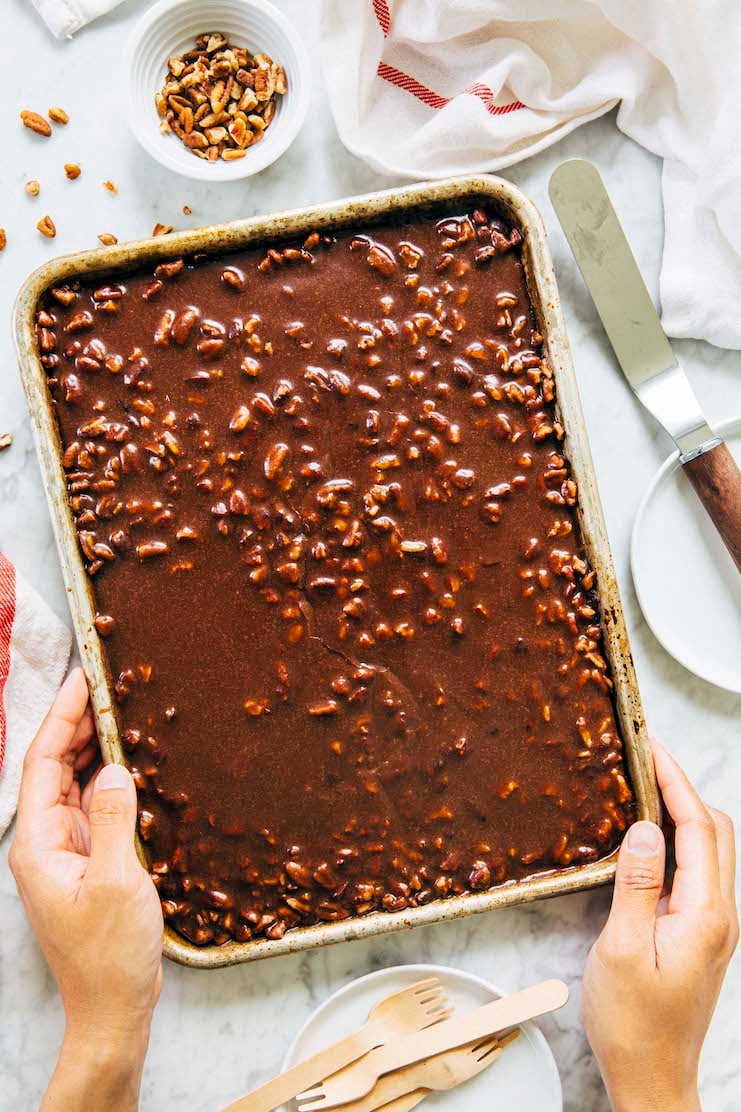
Ingredients and Substitutions
- All Purpose Flour. You can use a 1-1 gluten free all purpose flour replacer to make the recipe gluten free. I like Bob’s Red Mill Gluten Free 1 to 1 Baking Flour or King Arthur Flour Gluten Free All Purpose Flour.
- Kosher Salt. Kosher salt is the best salt for baking recipes. But you can replace the kosher salt in the recipe with table salt. Just use half the amount listed in the recipe when you do!
- Cocoa Powder. Although Dutch-processed cocoa powder can’t always be substituted for natural unsweetened cocoa powder, it will work in this recipe. Just note that your Texas sheet cake will come out darker in color than mine—but don’t worry! It will still be tasty.
- Buttermilk. No buttermilk? No problem. Check out my recipe for how to make buttermilk at home with other ingredients like milk, lemon juice, vinegar, and more.
- Whole Milk. You can replace the whole milk with low fat or skim milk, but these milks will lead to less flavorful baked goods. You can also replace the whole milk in this recipe with the same amount of plant-based milk of your choice. However, be mindful that using an alternative milk with “strong” flavors (like coconut or oat milk) will impart their flavors into the cake, too.
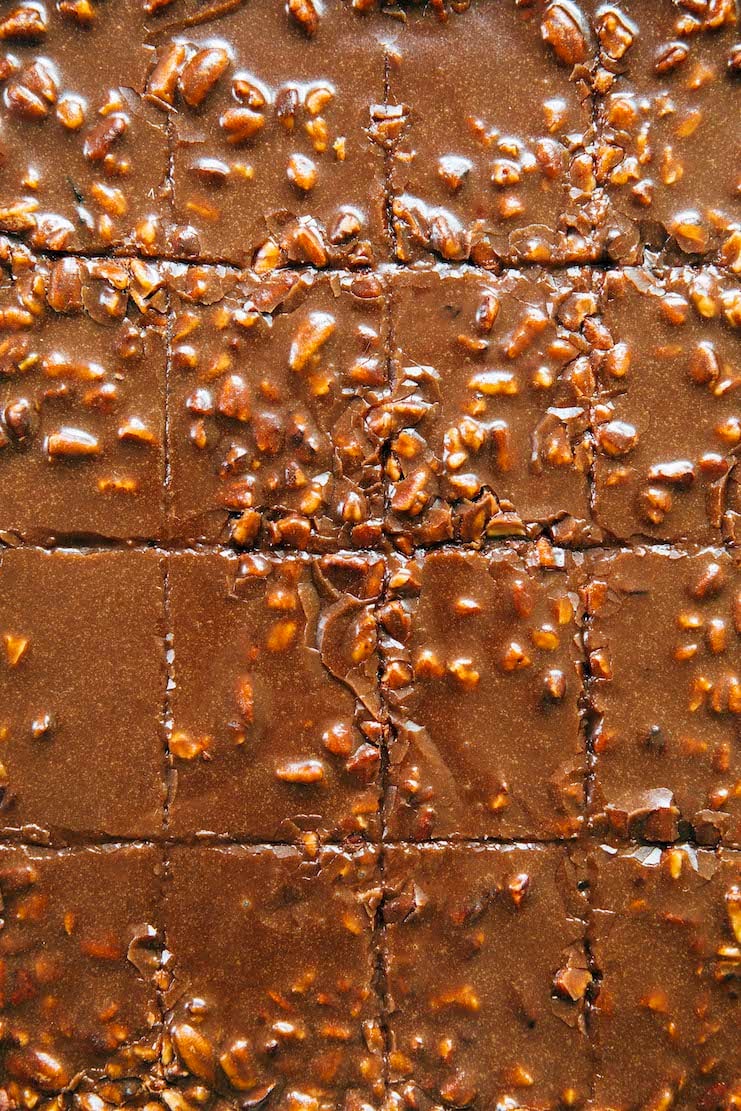
Recipe Troubleshooting and FAQ
What is a Texas sheet cake pan?
Most Texas sheet cake recipes instruct you to bake the cakes in a jelly roll pan. I personally hate this instruction. Why? It turns out that there’s no “official” definition for what that actually means. Some sources argue that jelly roll pans are the same size as half sheet pans (which are 13 x 18 inches). Others argue that they are slightly smaller and clock in at 10 x 15 inches.
In any case, I advise you to find a recipe that specifies the exact kind of sheet pan to use for the cake. Like this recipe! This recipe uses a 9 x 13 inch sheet pan with 1 inch tall sides to make the Texas sheet cake. Those are also the dimensions for a “quarter sheet pan.” Traditional, larger batch Texas sheet cake recipes will instruct you to make the recipes in a 13 x 18 inch sheet pan with 1 inch tall sides (which are also the dimensions for a “half sheet pan”).
For this recipe, I used the following quarter sheet pan. I’ve had it since 2012 and it is unstoppable!
Help! My frosting was super lumpy after I added in the confectioners’ sugar. What did I do wrong?
Absolutely nothing. When you first add the confectioners’ sugar to the rest of the frosting, it will look super lumpy. This is totally normal—I promise! Just keep whisking everything over medium-low heat until the lumps smoothen themselves out. If, after 5 minutes, your frosting still looks super lumpy, don’t panic! Instead, turn the stovetop up to medium and whisk continuously. The higher heat will help smoothen the frosting.
Help! I made the frosting too soon and it set and developed a crust on top before the cake was done. What can I do to fix it?
Ah, yes. Throughout this blog post, I repeatedly warn you that the frosting’s surface has a tendency to “crust” if made too soon. But don’t worry, it’s fixable! Simply keep the frosting in the saucepan over medium-low heat, and whisk continuously to dissolve the crust. Continue whisking over very low heat until the frosting is ready to be poured over the cake.
My Best Recipe Tips
Prep Tips
- For this Texas sheet cake recipe, it’s especially important to prep the ingredients for both the cake and frosting before starting any of the recipe steps. Why? You need to pour the frosting onto the cake while both the frosting and cake are still warm. That means you’ll need to make the frosting while the cake is baking in the oven and time it so that both are ready at the same time. Set yourself up for success and make sure you have everything you need beforehand!
Technique Tips
- This recipe uses a vintage technique to make the cake batter. First, you need to melt the butter in a saucepan, then add the cocoa powder, water, and the dry ingredients. Once you add the dry ingredients, the batter will be lumpy. Don’t panic—this is totally normal! Simply mix the dry ingredients until all of them are moistened and no major dry spots remain. Once you add the wet ingredients (a mixture made from egg, buttermilk, and baking soda), the batter will smoothen itself out.
All About That Delicious Frosting
- The fudge frosting’s surface tends to harden if left unstirred too long—this is totally normal, and a desirable quality for Texas sheet cake frosting! However, if it hardens too much, it can be hard to pour onto the cake. So I suggest making it when there is only 10 minutes left to go (since it takes that amount of time for the frosting to come together), and whisking it slowly over very low heat until the cake is ready.
- You need to pour the fudge frosting over the cake while it is still warm and fresh from the oven. Doing so ensures a perfectly smooth, candy-like frosting that cracks into chocolate shards when sliced!
- Similarly, although this cake is delicious while still warm and fresh from the oven, I recommend cooling it completely before serving. Doing so allows the frosting to cool and harden into a candy-like chocolate fudge shell. This texture is key to the Texas sheet cake experience! You want a super moist and soft cake topped off with an ever-so-slightly toothsome fudge frosting.
Get the Recipe: Texas Sheet Cake for 9 x 13 Inch Pan Recipe
Ingredients
For the Texas Sheet Cake
- 1 cup (4.5 ounces or 128 grams) all-purpose flour
- 1 cup (7 ounces or 198 grams) granulated sugar
- ½ teaspoon kosher salt
- ½ cup (1 stick or 4 ounces or 113 grams) unsalted butter, still cold from the fridge, cut into 1-inch cubes
- 2 Tablespoons natural unsweetened cocoa powder
- ½ cup (4 ounces or 113 grams) boiling hot water
- ¼ cup (2 ounces or 57 grams) buttermilk, still cold from the fridge
- 1 large egg, still cold from the fridge
- ½ teaspoon pure vanilla extract
- ½ teaspoon baking soda
For the Texas Sheet Cake Fudge Frosting
- ¾ cup (3.5 ounces or 99 grams) pecans, roughly chopped into ½- to 1-inch pieces
- ½ cup (1 stick or 4 ounces or 113 grams) unsalted butter, still cold from the fridge, cut into 1-inch cubes
- 2 Tablespoons natural unsweetened cocoa powder
- ¼ cup (2 ounces or 57 grams) whole milk, still cold from the fridge
- ½ teaspoon pure vanilla extract
- 2 cups (8 ounces or 227 grams) confectioners' sugar
- ¼ teaspoon kosher salt
Equipment
- a 9 x 13-inch sheet pan
- 2 medium, heavy-bottomed saucepans
- a heatproof rubber spatula
- a wire rack
- a whisk
Instructions
For the Texas Sheet Cake for 9 x 13 Inch Pan
- First, make the sheet cake. Position a rack in the center of the oven and preheat the oven to 350°F. Lightly spray a 9 x 13-inch sheet pan with cooking spray.
- Mix the dry ingredients. In a small bowl, whisk together the flour, sugar, and salt.
- Melt the butter, then add the cocoa, water, and dry ingredients. In a medium, heavy-bottomed saucepan, melt the butter over medium-low heat. Once the butter has melted, add the cocoa powder and water, mixing together with a heatproof rubber spatula to combine. Bring to a boil over medium-high heat and boil for 30 seconds.Remove from the heat and place on a wire rack. Immediately add the dry ingredients and mix until smooth. Allow to cool slightly while you prep the rest of the ingredients.
- Whisk the buttermilk, egg, vanilla, and baking soda, then add to the cocoa mixture. In a small bowl, whisk together the buttermilk, egg, and vanilla until combined. Whisk in the baking soda, then immediately add the entire mixture to the cocoa mixture in the saucepan and mix until just combined.
- Assemble the cake for baking. Pour the batter into the prepared pan. Pick up the pan and tilt it from side to side to spread the batter into a thin, even layer across the pan.
- Bake the cake. Bake for 20 to 22 minutes, or until the top of the cake bounces back when gently pressed and a skewer inserted into the center of the cake comes out with a few crumbs attached.
- Meanwhile, toast the pecans for the frosting. Spread the pecans in a single layer across a medium frying pan. Cook over medium heat for 5 to 10 minutes, using a heatproof rubber spatula to toss the nuts every 2 to 3 minutes, until fragrant and brown. Once toasted, scrape the nuts onto a plate fo prevent them from cooking further.
- Make the frosting. In another medium, heavy-bottomed saucepan, melt the butter for the frosting over medium-low heat. Once the butter has melted, add the cocoa powder for the frosting, whisking together to combine. Once combined, add the milk, vanilla, confectioners' sugar, and salt. Continue to cook over very low heat, whisking continuously, until no lumps from the confectioners' sugar remain and the frosting is very smooth, about 5 minutes. At this point, the cake should be done baking.
- Assemble the cake. Place the warm cake on a wire rack for assembly. Add the pecans to the frosting and mix to combine, then pour over the warm cake. Immediately pick up the pan (be careful—it will still be hot, so use oven mitts!) and tilt it from side to side to spread the frosting into a thick, even layer across the cake. Cool the assembled cake on the wire rack for 1 hour, or until the frosting has set and feels solid when gently pressed.
- Serve and store. Serve at room temperature. The Texas sheet cake will keep, covered tightly in plastic wrap, at room temperature for up to 3 days.
Notes
Can you freeze Texas sheet cake?
Yes, you can freeze the Texas sheet cake in the following ways:Freeze the unfrosted chocolate buttermilk cake for frosting later.
Follow the recipe instructions to make and bake the chocolate buttermilk sheet cake. However, don’t make the frosting! Instead, cool completely on a wire rack. Once cool, tightly wrap the cake, still in its sheet pan, in plastic wrap. Freeze for up to 3 months. When ready to serve, let thaw at room temperature for 2 to 3 hours. Preheat the oven to 350°F. Bake for 10 minutes to rewarm and set on a wire rack. Pour the warm frosting over the cake and follow the instructions to cool and serve the cake.Freeze any leftover slices of the assembled Texas sheet cake.
Tightly wrap any leftover slices of cake in plastic wrap and freeze for up to 3 months. To serve, transfer to the refrigerator to thaw overnight. Eat chilled, or rewarm for 10 to 20 second intervals in the microwave until room temperature.Did you make this recipe?
Please leave a comment and rating for the recipe using the form below!
Your ratings make it easier to find the recipe online, and I’m always looking for ways to improve Hummingbird High.

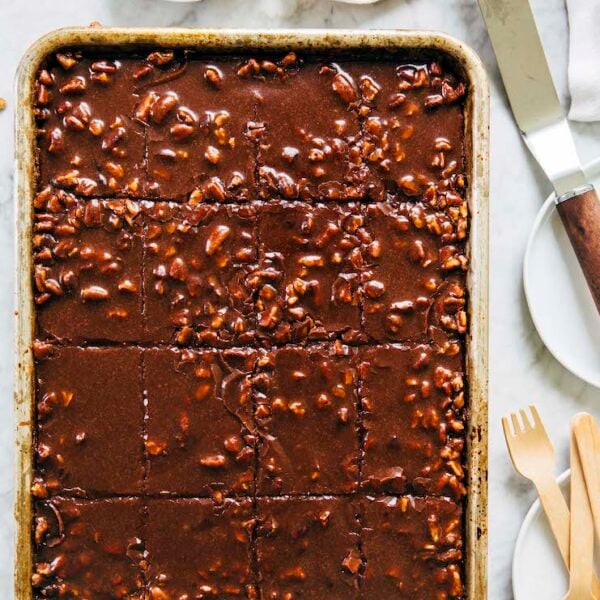
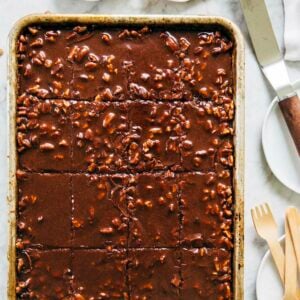
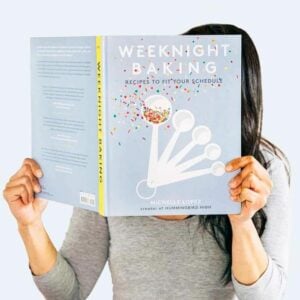

I grew up eating Texas sheet cake, so I know what it should be like, and mine did not come out right! I followed the instructions carefully (measured all my ingredients by weight), but my frosting came out very thin and runny, and didn’t set at all. It just soaked into the cake, so it came out more like a chocolate drizzle cake, it didn’t have that wonderful fudgy topping. Any ideas on what could have gone wrong?
Hi! Oh no, I’m so sorry to hear that! Are you absolutely sure you followed the recipe to the tee? Because I just double checked everything and it was correct against my notes; a handful of other people made this recipe over the weekend too, and theirs came out perfectly (I’ve even shared their results in my Instagram Stories if you want to take a peek!). It sounds like maybe the frosting was missing an ingredient when you made it—did you add the powdered sugar?
I definitely added the powdered sugar, but something must have gone wonky somewhere… Maybe my scale was off or something. If others had it work as written, I’ll just try again! (To be clear, it’s still delicious so it won’t go to waste!)
That’s what mine did!
In response to Megan, “sifted” can be troublesome. (Ask me how I know!) There’s a difference between *3 cups of sifted powdered sugar*……and *3 cups of powdered sugar, sifted.* If you used the first technique, the result would be runny. If you used the second one, the result would be a thick chocolate frosting. If you did use the right way, then could it be you used 2 sticks of butter maybe? A half cup of butter is one stick. Other than that, I’m clueless! Just trying to help!😉
Hi. I can’t eat that much sugar so I have to make a low sugar version of this recipe. Is it possible to just use half a cup of powdered sugar in the frosting? I assume I have to reduce some of the liquid. Is that right?
Thanks so much.
Regards
Soroor
Hm, I’m not sure how to reduce the sugar in the frosting (because I’ve only made the recipe as I’ve posted it), but I typically use this guide when reducing sugar in recipes: https://food52.com/blog/15911-what-experts-know-about-reducing-sugar-in-baking-recipes
Loved this recipe. It’s just the two of us so a smaller portion was perfect. Directions were easy to follow and I love the toasted pecans. Definitely will make this again!
I didn’t want to make a large sheet cake, because we were having just a small birthday gathering for 5 people so this was perfect. We even had enough for the birthday gal to take half of it home. Delicious!
I followed everything to a T. It tastes great and reminds me of the birthday cakes my mom would make for me. However, the cake was only about 1/4” thick. Could it be because of the baking soda?? Thanks!
Texas sheet cake is supposed to be pretty thin, so I don’t think anything went wrong! I suggest using a smaller pan or doubling the recipe and baking in a 9 x 13 inch pan if you want a cake that’s more traditional. However, Bake Time will definitely change…
The frosting has waaaaay too much butter for the amount of powdered sugar. The longer I stirred, the more the butter separated out- I had to pour it out of the saucepan and blot the frosting with paper towels. I looked at comparable recipes and saw a lot more sugar added to that amount of liquid ingredients. Hopefully my effort to remove the excess butter was successful since I’m bringing this to a party.
This recipe was not quite like the Texas Sheet Cake one I have and made for many years. I would not even try this recipe for fear it would not go right given the amounts I read for ingredients.
The coco is not enough in the cake. The white sugar is not enough. But rather than complain I want to add this is also called Mexican Chocolate Sheet cake. It also has cinnamon in it. The cake does not raise much so it sometimes is called a bar or brownie.\
My name is Lee and I am a professional local baker.
This came out absolutely perfect for me. The frosting was like fudge and the cake is like an airy brownie. I will be making this recipe for a long time coming!!
The directions for the cake are quite confusing. Where exactly are the dry ingredients supposed to be added ? It says it in three different places.
Like you, I didn’t need a Texas sheet cake big enough to feed an army. This one is PERFECT! It came together so easily on the stove with no messy bowls of batter to deal with. And you are right — the key to success is having all your ingredients measured out and ready to go (or at least at hand to get to easily), especially for the frosting. By the time I toasted my pecans and got the lumps of confectioner’s sugar melted away, it was time for the cake to come out of the oven. It had a beautiful shiny glaze and it is absolutely delicious. This recipe is a keeper!
My frosting did what Megan’s did!
Great Great I have made this sheet cake several times.Thank you delicious 😋 😀 😍 😜 😄 😊
Absolutely delicious. I didn’t have buttermilk so just added a squeeze of fresh lemon juice to milk and let it sit for 5 min. Most important change I made was to double the icing amount since the icing in the recipe just covered the cake but I like “higher” icing!
This is not a cake you want to make with limited counter space or in a travel trailer with a finicky, unlevel propane stove. But, not being a fisherman, I decided to try it while the hubby brought home dinner. It sank in the middle and the edges were a bit thin. The frosting has wrinkles– but that’s okay! I am going to tell the hubby it is a senior citizen Texas cake! It tastes great, however. The poor checker at the little country store is probably still telling people about the old woman who wanted such weird things! I substited some coffee from the bottom of yesterday’s pot for the water. My dog and cat are having me commited!
Awesome recipe! I was looking for a smaller version of the full size Texas sheet cake to make for our American Legion’s Veteran’s Day bake sale on November 11th and this is perfect! I only made one adjustment and that was I used 1/2 cup of hot Espresso in place of the hot water. I have always done this in my original Texas sheet cake recipe and it really intensifies the chocolate flavor! This is just my personal preference but I highly recommend! Thank you for an amazing recipe and I found the 9x13x1″ pans on Amazon for a great price.
Yes I made this cake using your recipe for buttermilk and it went off the chain! Thank you for your recipe I will be making more! Super easy to make and a great crumb as well.